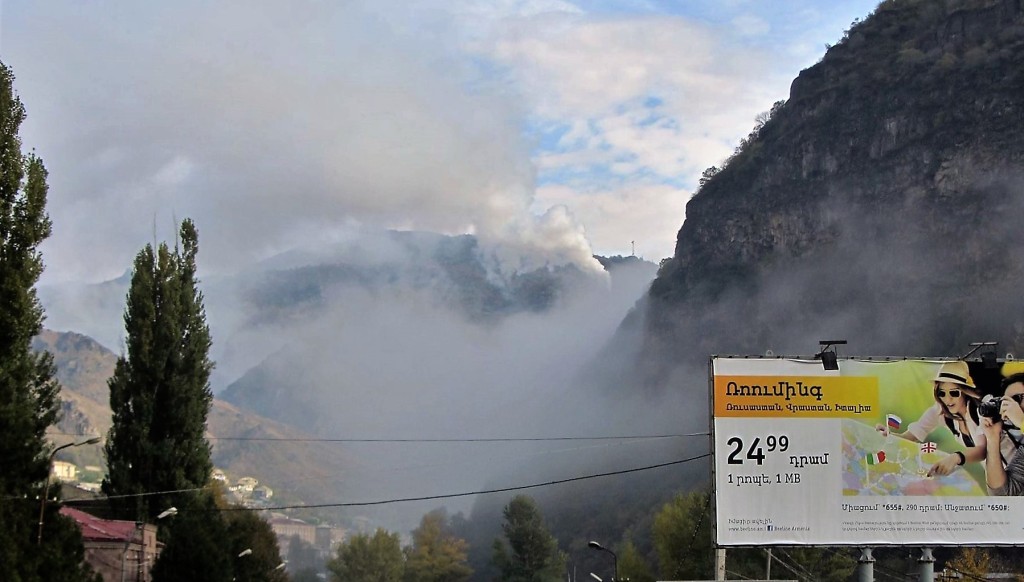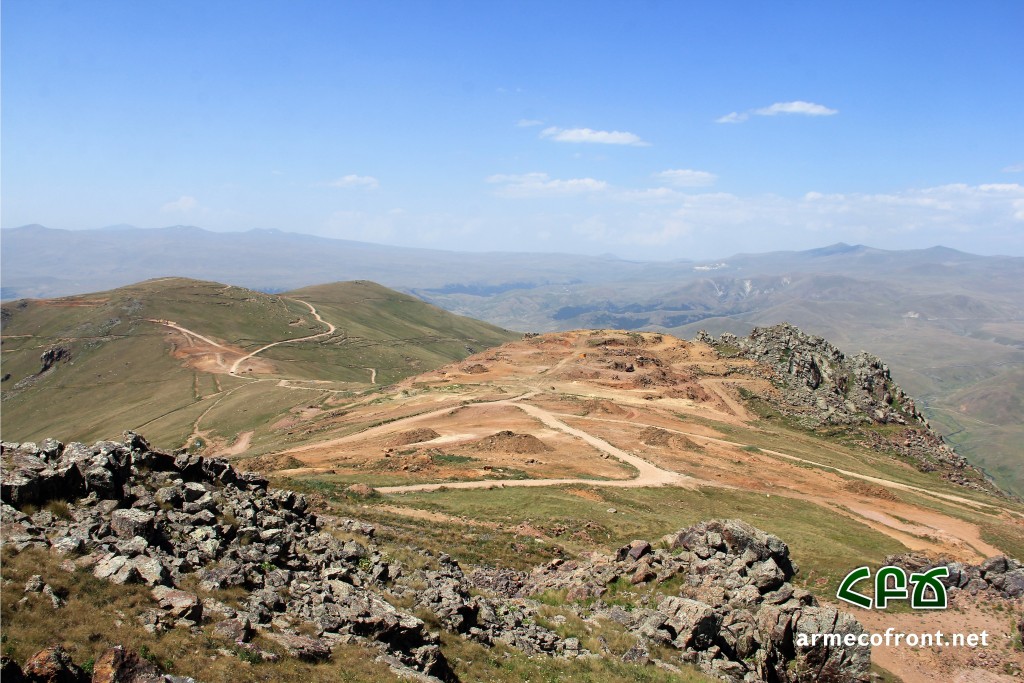The Breath of Death? Concerns Grow Over Impact Alaverdi Copper Smelter has on Health
By Marianna Grigoryan and Arpi Harutyunyan
ArmeniaNow reporters
04/28/2006

When doctors in the Spandaryan district of Alaverdi are late for work at the local hospital, their boss points out the window to the tall chimney of a copper-smelting plant that belches pungent smoke. “The reason for being late is neither transportation, nor habit,” says Dr. Hamlet Shahinyan. “Instead of coming to work, they stop their children’s nosebleeds. Everybody knows what the reason is.”
For the 22,000 residents of Alaverdi, the operation that takes mined copper ore and turns it into metal is both the economic lifeblood of the town and a source of growing concern about its effects on health and the environment. For some, smoke from that landmark chimney signals security. For others it is an ominous cloud of an unhealthy and potentially damaged future.
Residents interviewed by ArmeniaNow complained of deteriorating environmental conditions and health problems – including the nosebleeds Dr. Shahinyan describes.
Health and environmental officials also express concerns about the plant, which was built in 1963 and has operated ever since – except for an 8-year period after the collapse of the Soviet Union. They say a rise in the number of health problems and birth defects among residents, and high levels of sulfur dioxide and other toxins should signal alarm.
“The appearance of the numerous problems in Alaverdi is mostly connected with the uncontrollable emissions of the plant and the contaminated environment as its consequence,’ says Alaverdi Mayor Arthur Nalbandyan. `Everybody knows about the influence and the consequences of the smoke.”
There are regulations in place that should make any concern about health less costly, if not less certain. Under Armenian law, companies that exploit natural resources must pay annual environmental impact payments to the government. A law adopted in 2001 requires that a portion of those payments be returned to the originating communities to mitigate the effects of mining or hazardous materials. But local officials – including the mayor of Alaverdi – say that money is rarely returned by the central government, undermining their efforts to clean up ecological hazards. The government, meanwhile, says documents must be filed making a claim on the allotted money and that some communities – including Alaverdi – have not filed the proper documents.
Representatives of the company that run the operation, the Armenian Copper Programme (ACP) say that over the next two years they plan to install filters on the 100-meter smokestack to replace those removed when the plant was shut down nearly 20 years ago. While ACP did not say how much it planned to spend, informed outsiders speculate it could cost as much as $50 million, and those interested observers are skeptical whether the company will invest that much
for environmental protection.
While announcing intentions to improve emissions control, ACP denies a
connection between their plant and a reported increase in health defects and other problems, dismissing complaints as criticism fostered by high unemployment and the fact that the plant employs only a fraction of the workforce it had in Soviet times.
Whatever the speculation, some matters are well accounted: Smoke billows from the ACP stack. Haze hangs in the air over the town. Local farmers and fruit growers blame runoff from mines for polluting Debed River, a source for irrigation.
Some residents talk freely of problems they say are a direct result of the smelting process. Others avoid the topic in a community where the copper- smelting operation is the main private-sector employer.
Birth Defects on the Rise
Health workers in town say pollutants and emissions from the mine and smelter almost certainly are a factor in the patients they treat, including respiratory problems and women with pregnancy complications. “Of course the evolution of deficiencies is greatly connected to the contaminated environment since almost all the (emissions) are capable of causing deviations and deficiencies in organisms,” says Gayane Avagyan, a specialist in the Ministry of Healthcare’s department for women and children.
Dr. Amalia Azatyan, the chief physician at the town’s maternity hospital, says there have been an unusually high number of cases of hydrocephaly, or excessive amounts of water in the brain; anencephaly, the absence of part of the brain and skull; and “two-headed” fetus, a sack resembling a head filled with water.
One young Alaverdi resident says she was forced to abort her 7-month pregnancy in October 2005 after doctors determined that her baby would be born without part of its brain. She blames the polluted air in the town, where high cliffs on two sides hold the air like a bowl. “I felt very bad during the pregnancy. I was choking, I couldn’t breathe, there was no air,” says Siramarg Evoyan, 23, whose first child was born without complications in 2000.
While doctors did not directly link Evoyan’s complications to the plant emissions, statistics from the Ministry of Healthcare report a rise in birth defects and complications since 2000.
Dr. Azatyan also reports abnormal numbers of children born with cleft palate, and cases of contorted or missing appendages. She described the situation
as “horrifying.” “I don’t have an answer to the question of what is the reason for those kinds of deficiencies, because there is no complete analysis,” Dr. Azatyan says. “However I am confident the contaminated environment has its role in all these. It affects people, and pregnant women are more sensitive, and fetuses even more.”
Until last May, the Alaverdi Maternity Hospital lacked the equipment to do specialized testing of fetuses. Now physicians are better able to detect
defects in the unborn. “Problems of pregnant women and anomaly births have become so frequent that
women who visit the ultrasound testing for the first time, most of all are interested whether their child is normal or if it has deformities,” says Roza Machkalyan, who heads the hospital’s consultation department.
In Alaverdi, government statistics show a troublesome rise cancer and in prenatal and pediatric disease: The number of cases of malignant neoplasm – a tumor or tissue containing abnormal growth – grew from 360 in 2002, to 392 in 2003 and 411 in 2004. In 2001 697 children under 14 were diagnosed with respiratory illnesses, while by 2003 the number had doubled, to 1,389. Karlen Evoyan says nature is feeling the impact, too. “My apple garden that used to give me 4 tons of crops every year went totally dry over several years,” he says. “There are many bee-keepers here, but the bees have died out over the years.”
Company Defends its Turf
Armenia’s home-grown environmental movement in the late 1980s fought to close the Alaverdi copper-smelting plant, then a state-owned operation that was one of the most prolific in the Soviet Union. Private investors bought the plant 10 years ago and resumed production,
although the workforce of 500 is one-tenth the 5,000 employed during the Soviet years. Today, representatives of the company dismiss criticism from the townspeople and health workers.
A representative of the company, Andranik Ghambaryan told ArmeniaNow
that “everything is under control”. He denies that pollutants from the plant are related to birth defects and other problems. Plant management assessment isn’t consistent, however, with Ministry of Health Care statistics showing that: In 1992, when the plant was not working, no birth defects were registered in Alaverdi. By 2001 – five years after the plant re-started – there were 28
cases; and by 2004 the figure grew to nearly four times that, at 107.
“This information is false,” Ghambaryan says. “No one can deny the existence of emissions, but they don’t cause damage. People spread such information because the plant at present has 10 times less workers than it used to have and the people are unemployed.”
Doctor Azatyan, knows unemployment is a problem for Alaverdi, but her
experience and the problems evolving each month surprise even the experienced doctor. According to her each time she goes to the Ministry of Health Care for a report, specialists are taken by surprise at the long list of deformities and health problems.
Over the past year “the situation is horrifying,” she says. “We have had all those cases with vividly exposed deformities we have never had before.” The Chief Doctor says the reason the maternity got ultrasound equipment, is because the Ministry of Health Care recognized a problem in Alaverdi, and put the machines in place.
Linked in Industry
For at least two generations, the city and the smelting operation have been partners. After opening 43 years ago, the plant would become one of the largest of its type in the Soviet Union, producing up to 55,000 tons of refined copper. At its peak, the operation employed nearly one-fourth of the town’s residents. But some 20 years ago, the place for jobs also became a source of health concern for Alaverdi residents.
“In the late 80’s the growth of the volume of production was accompanied by a drastic growth in the emissions of the plant,” says Rafik Ghazinyan, chairman of the Debed environmental organization and a leading environmental campaigner.
One of the byproducts of copper smelter is sulfur dioxide, a pungent, toxic gas that is an ingredient in acid rain. Acid rain – which results from the mixture of precipitation with high concentrations of sulfur dioxide and other toxins – can be carried long distances and damage or destroy ecosystems and pollute waterways.
Ghazinyan recalls that water-mixed emissions were pouring into the Debed River, water that is used for irrigation. “The Debed turned into a dead river in those years, the fauna in it vanished,” he says.
Armenia’s burgeoning environmental movement – sparked by concerns over safety of the Metsamor nuclear power plant – and the decline in Soviet influence, led authorities to close the state-owned mine and smelter in 1988. Parts from the mining operation were dismantled and sold off, including the expensive filters that reduced caustic emissions.
The closing of the plant spared residents some of the environmental concerns that helped instigate the closure, but at the cost of 5,000 jobs. The copper mine and smelter resumed operations in 1997 under the ownership of Russian-Armenian investor Valery Mezhlumyan, chairman of the Armenian Cooper Programme. The plant began a pilot program of production straight away, but it was not until 2000 – 12 years after its shutdown – that it resumed major operations. According to the company’s Web site (www.copper.am) ACP wants to expand its exploration, processing and marketing of minerals and metals in Armenia.
Townspeople say air quality and the environment improved when the copper mine and smelter closed, but problems have returned when they reopened. “Our town is located in the gorge and the plant emissions pour into the atmosphere and stay over the town,” says Ghazinyan, who led the protest against the copper operation in 1988. (Owners and management of the plant do
not live in Alaverdi.)
Environmentalists say the white, 100-meter chimney of the copper smelter emits sulfur dioxide 24 hours per day. People close their doors and windows as a defense against the smog and smell.
“People are naïve enough to think they are safe from the white clouds of emissions constantly going out in their neighborhood by closing the doors and the windows. But nothing can help,” says Hovik Avetisyan, an Alaverdi physician.
Environmentalists, health workers and town authorities say the reopening of the plant without filtering equipment has hurt the town. “Problems began after the reopening of the plant,” says Larisa Paremuzyan, mayor of Alaverdi from 1989 to 1991 and now chairwoman of the Women’s Support Center. “Although from the very beginning the consequences of the production without filters were predictable, the real situation exceeded our
expectations.”
While denying accusations that the plant is a health risk, officials there say plans are in place that should improve emissions control. “By the end of 2008, filters will be set for operation in two stages to solve the ecological problems,” says Taguhi Karapetyan, who heads the company’s information department.
Emissions Exceed Government Limits
There are no current plans to improve air or water quality in Alaverdi, even though the Ministry of Environmental Protection’s own studies indicate that emissions of sulfur dioxide, dust and nitrogen dioxide – a gas that can cause breathing difficulties – exceed what are considered healthful limits. Levels of sulfur dioxide were more than 10 times the legal limits – the worst of the cities monitored. The MEP says it is not within its jurisdiction to implement improvements, it can only set and control policy.
If Armenia’s novice environmentalists saw it as a victory when the plant was closed in 1988, then veterans of the movement surely have no cause to celebrate today. When the plant was closed due to health concerns, it exceeded permissible emissions of sulphur-based pollutants by 7.2 times. But today the plant pumps out 10.6 times the allowed level, and no one is stopping it. Health workers say such pollutants can cause inflammation of the mucous membrane, respiratory problems, weakened mental aptitude and immune system. Emil Babayan, who heads the industrial toxicology lab at the Institute for General Hygiene and Vocational Diseases in Yerevan, says the copper production in Alaverdi involves a number of chemical elements – including lead, cadmium, iron, molybdenum and arsenic.
“The combination of arsenic and sulphur dioxide, along with cadmium, is considered to be cancer-generating material. The latter also affects the kidneys. And lead is classified among extremely toxic materials that can affect the human reproduction function, causing disfigurement and anomalies,”says Babayan.
Jobs vs. Health
Shortly after the Alaverdi plant reopened, doctors urged a non-government environmental organization to undertake measures to reduce emissions at the plant. “We appealed to the UN Development Program to study the causal relationship between illnesses and emitted gases,” recalls Aida Iskoyan, chairwoman of the Legal Protection of the Environment organization. `But the project was suspended because the people were afraid the study would cause closure of the plant. People wouldn’t agree to that as there was a social issue. And no one spoke of installing filtering equipment: the plant said it had no means.’
Now that the plant officials say they intend to install the filtering system – with new and used equipment from Slovakia – residents and even some town officials are skeptical. Still, jobs are needed and a portion of the populace that has been sustained by copper smelting would like to see it operate indefinitely.
Mayor Nalbandyan says the town faces a difficult choice – protecting its health or keeping an important employer and a fixture in the town’s history. “Nobody wants the plant to be closed down, nobody imagines Alaverdi without the plant,” he says.









